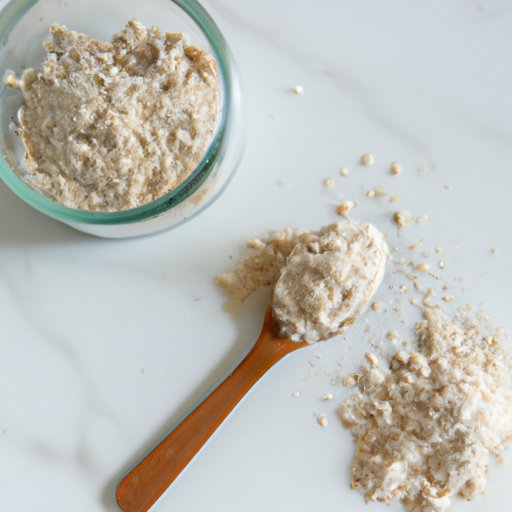Introduction
Oat flour is a versatile gluten-free alternative to wheat flour that’s gaining popularity in recent years. It’s a healthy and nutrient-dense option that’s becoming more widely available in grocery stores, health food stores, and online. In this article, we’ll delve into the question, “Is oat flour gluten-free?” and explore the many benefits of using oat flour in baking and cooking.
The Truth About Oat Flour: Is It Really Gluten-Free?
People with celiac disease or gluten sensitivity must avoid foods that contain gluten, including wheat, barley, and rye. However, oats have long been a source of controversy when it comes to gluten-free diets. While oats don’t technically contain gluten, they are often grown, processed, and transported in the same facilities as wheat and other gluten-containing grains, leading to cross-contamination issues.
Recent scientific research has shown that pure, uncontaminated oats are safe for most people with celiac disease and gluten sensitivity. However, it’s important to note that not all oat products are created equal. Consumers should look for oat flour that’s certified gluten-free to ensure that it’s been tested and verified to be free of contamination.
A Beginner’s Guide to Oat Flour: What You Need to Know About Gluten-Free Baking
Oat flour has many benefits for gluten-free baking, including a mild, nutty flavor and a high fiber content that gives baked goods a heartier texture. When substituting oat flour for wheat flour in recipes, it’s essential to remember that oat flour is denser and more absorbent than wheat flour, so it requires different measurements.
For example, when using oat flour for the first time, start with recipes that call for less wheat flour, or use a 3:4 ratio of oat flour to wheat flour. It’s also beneficial to add xanthan gum or arrowroot powder to gluten-free recipes to help bind the ingredients together and prevent crumbly texture. It’s best to follow gluten-free recipes rather than substituting oat flour for wheat flour in traditional recipes, as gluten-free baked goods require different ingredients and techniques.
To get started with oat flour, try using it in recipes like pancakes, cookies, muffins, and bread. Additionally, you can replace breadcrumbs with oat flour in meatballs or meatloaf for a gluten-free twist.
Oat Flour vs. Other Gluten-Free Flours: Which Is the Best Option?
While oat flour is an excellent option for gluten-free baking, it’s not the only option. Almond flour, coconut flour, and rice flour are also popular wheat flour substitutes, each with their unique benefits and drawbacks.
Almond flour and coconut flour have a higher fat content than oat flour, which results in a sturdier, more moist texture in baked goods. Rice flour is an excellent option for gluten-free baking and has a mild flavor that won’t overpower other ingredients, but it can be gritty in texture.
Ultimately, choosing the best gluten-free flour for your needs depends on the recipe and your personal preferences. It’s wise to try a few different gluten-free flours to determine which works best for your cooking and baking needs.
The Health Benefits of Oat Flour: Why It’s More Than Just Gluten-Free
Oat flour is a nutrient-dense, whole-grain flour that’s high in fiber, protein, and essential vitamins and minerals like manganese, phosphorus, and iron.
One cup of oat flour provides 16 grams of dietary fiber, which helps regulate blood sugar, promote satiety, and keep the digestive system healthy. It’s also a good source of soluble fiber, which has been linked to lower cholesterol levels and reduced risk of heart disease.
Additionally, oat flour contains more protein than many other gluten-free flours and is a good source of plant-based protein for vegetarians and vegans. Oat flour also has a low glycemic index, meaning it won’t cause spikes in blood sugar levels.
Beyond baking, oat flour can be used to coat vegetables or meats before frying, or added to smoothies or yogurt bowls for a protein and fiber boost.
Can Oat Flour Really Replace All-Purpose Flour in Every Recipe?
While oat flour can be used as a substitute for all-purpose flour in many recipes, it’s not always a 1-to-1 replacement. As mentioned earlier, oat flour is denser and more absorbent than wheat flour, so it requires different measurements and techniques in baking.
However, with a little practice and experimentation, oat flour can successfully replace all-purpose flour in many recipes, including bread, cakes, and cookies.
For example, you can make a delicious gluten-free oat flour banana bread by replacing all-purpose flour with oat flour, adding some mashed banana, maple syrup, eggs, and baking powder. Similarly, you can try making gluten-free oat flour pizza crust by combining oat flour, yeast, water, and olive oil and topping it with your favorite ingredients.
The Top Oat Flour Brands That Are Certified Gluten-Free
It’s important to look for oat flour that’s certified gluten-free to ensure that it’s safe to consume for people with celiac disease and gluten sensitivity. Some popular oat flour brands that are certified gluten-free include Bob’s Red Mill, King Arthur, and GF Harvest.
Conclusion
Oat flour is an excellent gluten-free option for those with celiac disease or gluten sensitivity. When using oat flour for baking, it’s essential to remember its dense and absorbent nature and follow gluten-free recipes carefully. Oat flour is also nutrient-dense and comes with many health benefits, making it an excellent addition to a balanced and healthy diet. While there are also many other gluten-free flour alternatives, oat flour is a versatile and accessible choice that’s worth trying.
